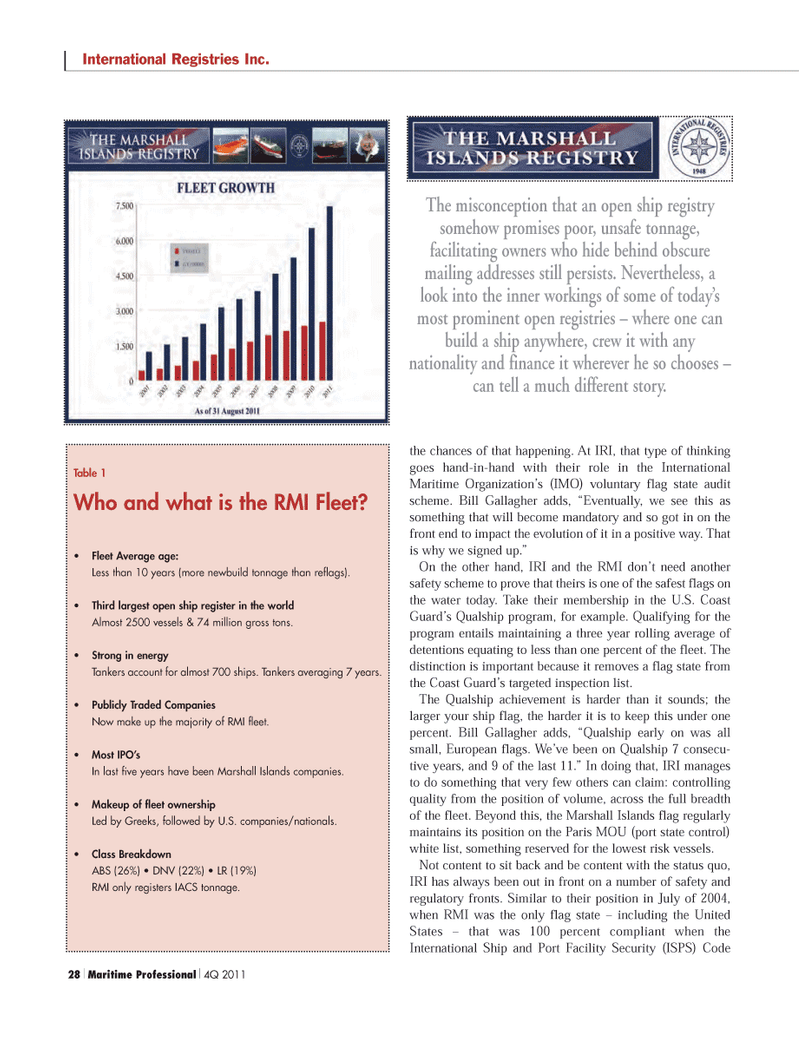
Page 28: of Maritime Logistics Professional Magazine (Q4 2011)
Classification
Read this page in Pdf, Flash or Html5 edition of Q4 2011 Maritime Logistics Professional Magazine
28 Maritime Professional 4Q 2011International Registries Inc.the chances of that happening. At IRI, that type of thinking goes hand-in-hand with their role in the InternationalMaritime Organization?s (IMO) voluntary flag state audit scheme. Bill Gallagher adds, ?Eventually, we see this as something that will become mandatory and so got in on thefront end to impact the evolution of it in a positive way. That is why we signed up.? On the other hand, IRI and the RMI don?t need another safety scheme to prove that theirs is one of the safest flags on the water today. Take their membership in the U.S. Coast Guard?s Qualship program, for example. Qualifying for the program entails maintaining a three year rolling average of detentions equating to less than one percent of the fleet. The distinction is important because it removes a flag state from the Coast Guard?s targeted inspection list. The Qualship achievement is harder than it sounds; the larger your ship flag, the harder it is to keep this under one percent. Bill Gallagher adds, ?Qualship early on was all small, European flags. We?ve been on Qualship 7 consecu- tive years, and 9 of the last 11.? In doing that, IRI manages to do something that very few others can claim: controlling quality from the position of volume, across the full breadth of the fleet. Beyond this, the Marshall Islands flag regularly maintains its position on the Paris MOU (port state control) white list, something reserved for the lowest risk vessels. Not content to sit back and be content with the status quo,IRI has always been out in front on a number of safety and regulatory fronts. Similar to their position in July of 2004, when RMI was the only flag state ? including the United States ? that was 100 percent compliant when the International Ship and Port Facility Security (ISPS) Code The misconception that an open ship registry somehow promises poor, unsafe tonnage, facilitating owners who hide behind obscure mailing addresses still persists. Nevertheless, a look into the inner workings of some of today?s most prominent open registries ? where one can build a ship anywhere, crew it with any nationality and finance it wherever he so chooses ? can tell a much different story. Table 1 Who and what is the RMI Fleet? Fleet Average age: Less than 10 years (more newbuild tonnage than reflags). Third largest open ship register in the world Almost 2500 vessels & 74 million gross tons. Strong in energy Tankers account for almost 700 ships. Tankers averaging 7 years. Publicly Traded Companies Now make up the majority of RMI fleet. Most IPO?s In last five years have been Marshall Islands companies. Makeup of fleet ownership Led by Greeks, followed by U.S. companies/nationals. Class Breakdown ABS (26%) DNV (22%) LR (19%) RMI only registers IACS tonnage.MP #4 (18-33):MP Layouts 11/8/2011 2:26 PM Page 28

 27
27

 29
29
